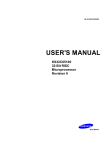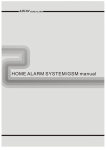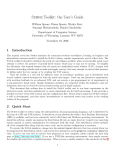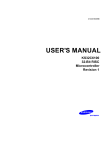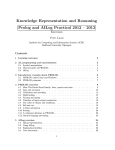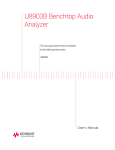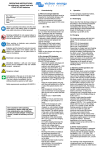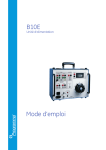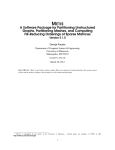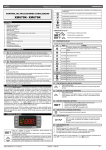Download Data Description - Health and Retirement Study
Transcript
HEALTH AND RETIREMENT STUDY Deceased Spouse Cross-Year Benefits Data Description and Usage Version 4.1, August 2015 To the Restricted Data Investigator: This restricted data set is intended for exclusive use by you and the persons specified in the Agreement for Use of Restricted Data from the Health and Retirement Study and/or the Supplemental Agreement with Research Staff for Use of Restricted Data from the Health and Retirement Study. If there are any questions about this data set and its use, refer to the HRS Restricted Data Web Site at http://hrsonline.isr.umich.edu/rda or contact the HRS Help Desk ([email protected]) by email. This document may not be reproduced without the written consent of the staff of the Health and Retirement Study, the Institute for Social Research, the University of Michigan. Table of Contents 1. Overview and Acknowledgments................................................................................................................ 3 2. Obtaining the Data ............................................................................................................................................ 3 2a. Restricted Data Agreement ................................................................................................................ 3 2b. Access to Restricted Data ................................................................................................................... 3 2c. Publications Based on Restricted Data ............................................................................................... 4 3. Setup ..................................................................................................................................................................... 4 3a. Distribution Set ................................................................................................................................... 4 3a-1. Windows Environment..................................................................................................................................... 4 3a-2. UNIX/Linux Environment ................................................................................................................................. 4 3a-3. Macintosh OS X Environment (10.4.x and above)............................................................................................ 4 Table 1: Contents of Distribution Package ............................................................................................... 5 3b. File Structure ...................................................................................................................................... 5 3e. Program Statements ........................................................................................................................... 6 3b-1. Using the Files with SAS .................................................................................................................................. 6 3b-2. Using the Files with SPSS................................................................................................................................. 6 3b-3. Using the Files with Stata ................................................................................................................................ 7 4. Cross-Year Benefit Data Set Content .......................................................................................................... 7 4a. Overview. ............................................................................................................................................ 7 Table 2: Record Counts ............................................................................................................................. 8 4b. Section A: Primary Beneficiary and Other Insured (Respondent). ..................................................... 8 4c. Section B: Benefits Paid Designation Indicator. .................................................................................. 9 4d. Section C: Monthly Benefit Amount. .................................................................................................. 9 4e. Section D: Monthly Benefit Credited. ................................................................................................. 9 4f. Section E: Monthly Benefit Paid. ......................................................................................................... 9 4g. Section F: LAF Status. ........................................................................................................................ 10 4h. Section G: Respondent Payment History. ........................................................................................ 10 4i. Section J: Respondent Type of Benefits............................................................................................. 10 5. If You Need to Know More........................................................................................................................... 10 5a. HRS Internet Site ............................................................................................................................... 10 5b. Contact Information....................................................................................................................... 11 Appendix A: Master Benefit Record Information.................................................................................... 12 I. General Information ............................................................................................................................ 12 II. Basic Monthly Benefit Information .................................................................................................... 12 Table 3: Type of Benefit (TOB) Codes ..................................................................................................... 13 III. Other Important Variables................................................................................................................. 14 IV. Questions and Answers about the HRS Benefit Files ........................................................................ 15 1. Why does it appear that the benefit record contains duplicate data elements? ............................................... 15 2. What is dual entitlement and how do I find them? ............................................................................................ 15 3. Are dual entitlement benefits always combined? .............................................................................................. 15 4. Can there be a second part to the benefit record even if there is no current dual entitlement? ...................... 15 5. How do I identify which respondents were paid benefits for the most recent month (or any specific month)? ................................................................................................................................................................... 15 6. What is the PIA and how does it change? ........................................................................................................... 16 7. What do benefit-amount and PIA fields mean for dually-entitled cases? .......................................................... 16 8. What about women who receive benefits based on someone else's work record? .......................................... 16 9. What other variables might be particularly useful to understand benefits received by women? ..................... 16 August 2015 1 XyrdSpBenDD2012 10. Which respondents took early Social Security retirement benefits and which respondents delayed their retirement? ............................................................................................................................................................. 17 11. How can I find respondents who worked after first taking Social Security retirement benefits? .................... 17 12. What should we know about suspensions and terminations? ......................................................................... 18 13. What information is available about Social Security disability benefits? ......................................................... 18 Appendix B: Data Availability by Source for Section A ......................................................................... 20 Appendix C: Deceased Spouse Benefits Data Availability by Source for Time-Series Variables ................................................................................................................................................................................... 26 August 2015 2 XyrdSpBenDD2012 1. Overview and Acknowledgments The Health and Retirement Study (HRS) is a national longitudinal study of the economic, health, marital, and family status, as well as public and private support systems, of older Americans. The HRS is a rich source of longitudinal, cross-sectional data for researchers and policymakers who study aging. Funding for the Health and Retirement Study is provided by the National Institute on Aging at NIH (U01AG009740), with supplemental support from the Social Security Administration. The study is conducted by the Institute for Social Research (ISR) at the University of Michigan. HRS gratefully acknowledges the special assistance of the Social Security Administration’s Office of Research and Statistics for their assistance in retrieving the administrative records of HRS respondents who gave consent for those records to be used for research purposes. 2. Obtaining the Data 2a. Restricted Data Agreement This restricted data set is intended for exclusive use by you and the persons specified in the Agreement for Use of Restricted Data from the Health and Retirement Study and/or the Supplemental Agreement with Research Staff for Use of Restricted Data from the Health and Retirement Study. If you have questions about the content and use of this data set, refer to the HRS Restricted Data Web site or contact the HRS Help Desk ([email protected]) by email. 2b. Access to Restricted Data Although most HRS data sets are available to the public without restriction, certain HRS data sets contain sensitive respondent information and are only available under terms of a formal agreement negotiated between the researcher and HRS. If you are a researcher who has found a restricted data file that is of interest, you should begin the application process by reviewing the application materials and procedures on the HRS Web site (http://hrsonline.isr.umich.edu). If you decide to go forward, you should submit a preliminary application package containing a research proposal and data protection plan to HRS. If problems are found with your application, the HRS staff members will contact you to provide assistance in resolving them. Otherwise, once you have been notified by HRS that your application is complete, you may submit your application to your local Institutional Review Board and/or Contracting Authority. After IRB approval is obtained, you should submit the signed originals of the institutional approval documents to the HRS. At this point the application is complete and it is forwarded to the HRS Data Confidentiality Committee (DCC) for review and approval. If approval is granted by the DCC, the Principal Investigator of the HRS will sign the restricted data agreement, and you will be sent the restricted data product(s) by the HRS. Note: access codes for your restricted data product(s) are sent separately. If institutional or physical circumstances change, (e.g., new persons added to the project, hardware/software changes, or office moves) you should contact the HRS in order to modify the underlying agreement. A yearly re-certification of your restricted data agreement is required; if you wish to continue with analysis of the data after the expiration of the initial agreement, you will need to submit a renewal request. Note: An HRS agent will periodically audit you in order to ensure that all conditions of the Restricted Data Agreement are being met. August 2015 3 XyrdSpBenDD2012 2c. Publications Based on Restricted Data Your restricted data agreement specifies that you will inform HRS of any papers, publications, or presentations based on this restricted data set. Please send a copy of such publications in PDF format via e-mail to [email protected] with "Attn: Papers and Publications" in the subject line. If you wish, you may include a bibliographical reference. As an alternative, you may transmit publications in paper format by postal mail: Health and Retirement Study Attn: Papers and Publications The Institute for Social Research, Room 3410 P.O. Box 1248 Ann Arbor, Michigan 48106-1248 3. Setup 3a. Distribution Set This data set is packaged for distribution in a .ZIP file, XyrDspBen.zip. In order to keep the contents secure, the .ZIP file has been encrypted using WinZIP 256 bit AES encryption. Extract the data file, the program statement file that matches your analysis environment, the data description (this file), and the codebook file. If you require a special file format or experience system problems, please contact the HRS Help Desk. If all files are decompressed, they will require approximately 100 MB of free space on your storage device. 3a-1. Windows Environment Copy the ZIP file to the Windows folder where you plan to do your work. Use a third-party1 file compression/decompression tool such as WinZIP or 7-zip to extract the ZIP folder contents. When you are prompted for the pass-phrase, respond with the character string that you received via e-mail. The output will be the files listed in Table 1. 3a-2. UNIX/Linux Environment Copy the ZIP file to the folder where you plan to do your work. Use the ZIP file decompression software installed on your system, (e.g. 7-zip, gunzip) to decrypt and extract the ZIP folder contents. When you are prompted for the pass-phrase, respond with the character string that you received via e-mail. The output will be the files listed in Table 1. 3a-3. Macintosh OS X Environment (10.4.x and above) Copy the ZIP file to the folder where you plan to do your work and use Stuffit-Expander to decrypt and extract the ZIP folder contents. When you are prompted for the pass-phrase, respond with the character string that you received via e-mail. The output will be the files listed in Table 1. 1 The built-in Windows decompression utility will not process AES-256bit encrypted zip files; it halts with “an unexpected error is keeping you from copying the file”. August 2015 4 XyrdSpBenDD2012 Table 1: Contents of Distribution Package Directory 2 c:\BenDspXyear\ c:\BenDspXyear\docs\ c:\BenDspXyear\data\ c:\BenDspXyear\sas\ c:\BenDspXyear\spss\ c:\BenDspXyear\stata \ File xyrbendsp.zip ben2A_d.txt ben2B_d.txt ben2C_d.txt ben2D_d.txt ben2E_d.txt ben2F_d.txt ben2G_d.txt ben2J_d.txt ben2A_d.da (n=1463) ben2B_d.da (n=59106) ben2C_d.da (n=67454) ben2D_d.da (n=67454) ben2E_d.da (n=67454) ben2F_d.da (n=67205) ben2G_d.da (n=52450) ben2J_d.da (n=59106) ben2A_d.sas ben2B_d.sas ben2C_d.sas ben2D_d.sas ben2E_d.sas ben2F_d.sas ben2G_d.sas ben2J_d.sas ben2A_d.sps ben2B_d.sps ben2C_d.sps ben2D_d.sps ben2E_d.sps ben2F_d.sps ben2G_d.sps ben2J_d.sps ben2A_d.do/.dct ben2B_d.do/.dct ben2C_d.do/.dct ben2D_d.do/.dct ben2E_d.do/.dct ben2F_d.do/.dct ben2G_d.do/.dct ben2J_d.do/.dct Type zip file Codebook files (ASCII text) Data files (ASCII text) SAS program statements SPSS program statements Stata dictionary and "do" files 3b. File Structure The files contained in this dataset contain information stored on two levels: Deceased spouse information linked to Respondent and to Respondent-Year. Respondent-level information reflects the status of the deceased spouse’s MBR record at the time of data extraction, keyed on HHID and PN (See 2 While a specific folder arrangement is not required for using HRS files, we have traditionally suggested a directory structure for the Windows environment. By using this directory structure, you will not have to change the path name references in your data descriptor files. If you do not use Windows, or if you use a different directory structure, just change the directory references in the program files. August 2015 5 XyrdSpBenDD2012 Ben2A_d, below). Year-level (January through December) data contain month-by-month information derived from the historical record and are keyed on HHID, PN, and YEAR (Ben2B_d, Ben2C_d, Ben2D_d, Ben2E_d, Ben2F_d, Ben2G_d, Ben2J_d). This structure mirrors that of the Respondent Cross-Year Benefits data set as illustrated below. 3e. Program Statements Each data file comes with associated SPSS, SAS or Stata program statements to read the data. Files containing SPSS statements are named with an .sps extension, those with SAS statements with an .sas extension, and those with Stata statements with .do and .dct extensions. The files are keyed on Household Identifier, Other Person Number and Sub-Household Identifier. See the appendix for usage details. 3b-1. Using the Files with SAS To create a SAS system file for a particular data set, two file types must be present for that data set -.sas program statement files and .da data files. To create a SAS system file, load the *.sas file into the SAS Program Editor. If the *.sas file is located in “c:\BenDspXyear\sas" and the data file is located in “c:\BenDspXyear\data", you can run the file as is. A SAS system file will be saved to directory “c:\BenDspXyear\sas". If the files are not located in the specified directories, you will need to edit the *.SAS file to reflect the proper path names prior to running the file. 3b-2. Using the Files with SPSS To create an SPSS system file for a particular data set, two file types must be present for that data set -.sps program statement files and .da data files. To create an SPSS system file, open the *.sps file in SPSS August 2015 6 XyrdSpBenDD2012 as an SPSS Syntax File. If the *.sps file is located in “c:\BenDspXyear\spss" and the data file is located in “c:\BenDspXyear\data", you can run the file as is. An SPSS system file (*.sav) will be saved to directory “c:\BenDspXyear\spss". If the files are not located in the specified directories, you will need to edit the *.sps file to reflect the proper path names prior to running the file. 3b-3. Using the Files with Stata To use Stata with a particular data set, the following three file types must be present for that data set -.dct files, .do files, and .da data files. Files with the suffix ".da" contain the raw data for Stata to read. Files with the suffix ".dct" are Stata dictionaries used by Stata to describe the data. Files with the suffix ".do" are short Stata programs ("do files") which you may use to read in the data. Load the .do file into Stata and then submit it. If the *.do and .dct files are located in “c:\BenDspXyear\stata" and the data file is located in “c:\BenDspXyear\data", you can run the .do file as is. If the files are not located in these directories, you must edit the *.do and *.dct files to reflect the proper path names before you run the files. 4. Cross-Year Benefit Data Set Content 4a. Overview. The Deceased Spouse Cross-Year Benefits dataset is derived from Master Beneficiary Record (MBR) data for primary beneficiary and other (secondary) insured. The inputs to this dataset were received at different points in time over the past decade from the Social Security Administration: In 1993 or 1995 for AHEAD cohort members In 1998 or 2000 for CODA and War Baby cohort members as well as new spouses In 2004 for EBB and HRS cohort members, new spouses, and War Baby 1998/2000 refusers In 2006 for respondents interviewed face-to-face who were not asked previously (or in the case of Early Boomers, refused or non-response). These permissions are prospective and provide for biennial updates through 2030. In 2008 and thereafter for face-to-face interviews. These permissions are prospective and provide for biennial updates through 2030. Prior to 2006, respondent permissions were based on separate agreements between HRS and SSA. This meant that information was obtained only for the time period covered by the agreement. In 2006 and thereafter, the terms of the permission agreement allow HRS to obtain biennial updates of earnings and benefits data through the year specified. Since each new record set obtained from SSA reflects the most recent information available, the latest version of the Deceased Spouse Cross-Year Benefits dataset will always be most accurate. If current information for a given respondent is missing, the most recent data elements from past datasets are used. See Appendix A for a detailed explanation of Master Beneficiary Record data usage. Three sets of files are included in this distribution package. They contain information for deceased spouses on: Benefits (Primary and Secondary/Other) o General Information Control Data Benefit Data Current Beneficiary Claim Data Latest Beneficiary Denial/Disallowance Data August 2015 7 XyrdSpBenDD2012 Latest Current Insured Status Dual Data Representative Payee Data Delayed Retirement Credit Data Latest Amount Offset Data Latest Government Pension Offset Data Latest Medicare Date Latest PIA History Latest Disability Data o Benefit Paid Designation Indicator o Monthly Benefit Amount (Based on PIA) o Monthly Benefit Credited (MBA rounded down) o Monthly Benefit Paid (MBC Part B Premium) o Monthly Ledger Account File (LAF) Status Payment History (Primary and Secondary/ Other) o Monthly Benefits Paid o Monthly HI-SMI Charges Type of Benefit (Primary and Secondary/Other) Table 2: Record Counts Primary Cohort 1993 NA HRS AHEAD CODA War Baby EBB MBB Total 0 249 0 0 0 0 249 Permission Set 1999 2004 1 0 241 0 23 10 28 0 4 0 11 0 0 10 308 Total 2006+ 447 207 135 37 44 26 896 1 688 479 173 41 55 26 1463 4b. Section A: Primary Beneficiary and Other Insured (Respondent). This section (ben2A_d) contains data from the Master Beneficiary Record (MBR) primary beneficiary and other (secondary) insured at the respondent level. As noted above, the most recent information for each deceased spouse is reported. This file (and accompanying year-level files) contains information for deceased spouses; it is keyed on the Household Identifier and Person Number of the respondent linked to the deceased spouse and matches the 2012 Tracker file. All payment fields have been rounded to the nearest $10, except entries originally between $1 and $10, which have been recoded to $10. Entries originally coded as 0 remained 0. If any entry was less than 0 it was recoded to -1. With the exception of certain date fields, all alphabetic variables have been converted to numeric values. In such cases, the SSA alphabetic codes have been incorporated into the code description. See Appendix B for an overview of the information contained in Section A. August 2015 8 XyrdSpBenDD2012 4c. Section B: Benefits Paid Designation Indicator. This file contains monthly benefits paid indicator information for deceased spouses of respondents who signed consent forms in 2004, 2006, 2008, 2010 or 2012. The file is keyed on Household Identifier, Person Number, and Year. See Appendix C for details on the relationship between variables contained in this section and the source of the original data obtained from SSA. 4d. Section C: Monthly Benefit Amount. This file contains monthly benefit amount information for deceased spouses of who signed consent forms in 1993/1995, 1998/2000, 2004, 2006, 2008, 2010 or 2012. The file is keyed on Household Identifier, Person Number, and Year. The Monthly Benefit Amount (MBA) is determined by the PIA. It is the amount payable after reduction of the PIA, if necessary, for age, family maximum, earnings in excess of the earnings test, the government pension offset (affecting widows) and other reasons, but before any deductions of the Medicare Part B (or SMI) premium. Any increase due to the delayed retirement credit is also reflected in the MBA. If the Ledger Account File (LAF) status in the month is C or C2, then a benefit has been paid on that account for that month. In order to preserve respondent confidentiality, the data fields in this section are rounded as follows: A code of zero (0) represents a true zero dollar amount. Values in the range $0.01 through $10.00 are recoded to $10.00, while values in the range -$0.01 through -$10.00 are recoded to -$10. Amounts with an absolute value of more than $10.00 are rounded to the nearest $10.00 dollars. Absolute values ending in 0.01 to 4.99 are rounded down, and absolute values ending in 5.00 to 9.99 are rounded up. Appendix C for details on the relationship between variables contained in this section and the source of the original data obtained from SSA. 4e. Section D: Monthly Benefit Credited. This file contains monthly benefit credited information for deceased spouses of respondents who signed consent forms in 1993/1995, 1998/2000, 2004, 2006, 2008, 2010 or 2012. The file is keyed on Household Identifier, Person Number, and Year. The MBC is the amount the beneficiary would pay taxes on. Under law, the MBC is calculated by first subtracting the Part B Medicare (or SMI) Premium (if any) from the MBA, then rounding the result down to the nearest whole dollar, and adding the part B premium to the rounded amount. If the Ledger Account File (LAF) status in the month is C or C2, then a benefit has been paid on that account for that month. In order to preserve respondent confidentiality, the data fields in this section are rounded as follows: A code of zero (0) represents a true zero dollar amount. Values in the range $0.01 through $10.00 are recoded to $10.00, while values in the range -$0.01 through -$10.00 are recoded to -$10. Amounts with an absolute value of more than $10.00 are rounded to the nearest $10.00 dollars. Absolute values ending in 0.01 to 4.99 are rounded down, and absolute values ending in 5.00 to 9.99 are rounded up. Appendix C for details on the relationship between variables contained in this section and the source of the original data obtained from SSA. 4f. Section E: Monthly Benefit Paid. This file contains monthly benefit paid information for deceased spouses of respondents who signed consent forms in 1993/1995, 1998/2000, 2004, 2006, 2008, 2010 or 2012. The file is keyed on Household Identifier, Person Number, and Year. The MBP is the MBC minus the Part B (or SMI) premium August 2015 9 XyrdSpBenDD2012 (if any) and reflects the dollar amount of the check or direct deposit that the respondent actually received. If the Ledger Account File (LAF) status in the month is C or C2, then a benefit has been paid on that account for that month. See Appendix C for details on the relationship between variables contained in this section and the source of the original data obtained from SSA. In order to preserve respondent confidentiality, the data fields in this section are rounded as follows: A code of zero (0) represents a true zero dollar amount. Values in the range $0.01 through $10.00 are recoded to $10.00, while values in the range -$0.01 through -$10.00 are recoded to -$10. Amounts with an absolute value of more than $10.00 are rounded to the nearest $10.00 dollars. Absolute values ending in 0.01 to 4.99 are rounded down, and absolute values ending in 5.00 to 9.99 are rounded up. 4g. Section F: LAF Status. This file contains monthly ledger account file status information for deceased spouses of respondents who signed consent forms in 1993/1995, 1998/2000, 2004, 2006, 2008, 2010 or 2012. The file is keyed on Household Identifier, Person Number, and Year. See Appendix C for details on the relationship between variables contained in this section and the source of the original data obtained from SSA. 4h. Section G: Respondent Payment History. This file contains monthly information on Monthly Benefits Paid and Monthly HI-SMI Charges for deceased spouses of respondents who signed consent forms in 2004, 2006, 2008, 2010 or 2012.. The file contains data for years 1984-2012 and is keyed on Household Identifier, Person Number, and Year. See Appendix C for details on the relationship between variables contained in this section and the source of the original data obtained from SSA. In order to preserve respondent confidentiality, the data fields in this section are rounded as follows: A code of zero (0) represents a true zero dollar amount. Values in the range $0.01 through $10.00 are recoded to $10.00, while values in the range -$0.01 through -$10.00 are recoded to -$10. Amounts with an absolute value of more than $10.00 are rounded to the nearest $10.00 dollars. Absolute values ending in 0.01 to 4.99 are rounded down, and absolute values ending in 5.00 to 9.99 are rounded up. 4i. Section J: Respondent Type of Benefits. This file contains monthly type of benefit information (retired worker, disabled, worker, aged spouse, etc.) for deceased spouses of respondents who signed consent forms in 2004, 2006, 2008; 2010 or 2012. The file is keyed on Household Identifier, Person Number, and Year. See Appendix C for details on the relationship between variables contained in this section and the source of the original data obtained from SSA. 5. If You Need to Know More This document is intended to serve as a brief overview and to provide guidelines for using the Deceased Spouse Cross-Year Benefits data sets. If you have questions or concerns that are not adequately covered here or on our Web site, or if you have any comments, please contact us. We will do our best to provide answers. 5a. HRS Internet Site The Health and Retirement Study maintains a Web site (http://hrsonline.isr.umich.edu) that provides access to public release data, questionnaires, codebooks, sample and response rate documentation, a August 2015 10 XyrdSpBenDD2012 bibliography, user guides, and extensive background information. If you want to find out more about restricted data products and procedures, visit the restricted data section of the HRS Web site (http://hrsonline.isr.umich.edu/rda). 5b. Contact Information If you need to contact us, you may do so by one of the methods listed below. Internet: Help Desk at our Web site (http://hrsonline.isr.umich.edu/help) E-mail: [email protected] Postal service: Health and Retirement Study The Institute for Social Research The University of Michigan P.O. Box 1248 Ann Arbor, MI 48106-1248 FAX: (734) 647-1186 August 2015 11 XyrdSpBenDD2012 Appendix A: Master Benefit Record Information3 I. General Information SSA administrative data are available for those HRS respondents who gave their signed permission to the HRS to obtain their administrative data from federal agencies and for whom SSA was able to validate a Social Security number (SSN) and locate appropriate records. In accordance with the governing Memorandum of Understanding, benefit information for the time period ending in December 2008 was released. HRS records were extracted after that date, with SSA making every effort to reconstruct all benefit information available prior to January 2009. Each benefit record set in this release has two parts. The first part describes the benefit, if any, that the respondent was receiving as of the most recent permission date (December 2008) and the historical data for that entitlement. The second part contains information for dually entitled beneficiaries; otherwise (e.g., for a retired worker with no other current benefits) these variables are missing. Variable names for fields in the second part start with “O;” otherwise, the metadata information for these fields duplicates the first part. Please see the discussion below on dual entitlements. Social Security data in these records are extracted from files designed for program administration, and not for research. They are inherently not "user friendly" and are easy to misunderstand. To a great extent that is because the programs are far more complicated than they appear initially. Users are urged to review the documentation carefully and to consult basic program information. Help is available on the Social Security Administration Web site; in particular, see Social Security Program Rules. In addition, see the Social Security Bulletin's Annual Statistical Supplement and the RAND Corporation's SSA Program Data User's Manual (Panis et al., 2000).4 II. Basic Monthly Benefit Information From January 1962 through December 20085 benefit variables are available on a monthly basis: Monthly Benefit Amount (MBA), Monthly Benefit Credited (MBC), and the Monthly Benefit Paid (MBP). However, these benefit amount variables should only be used in conjunction with the Type of Benefit (TOB) (Table 1, below) variable, constructed by the SSA Research Office for each month. The TOB is a function of several administrative variables including the ledger account file (LAF) variable for the month. Two important general points should be made about the Social Security benefit records. First, the benefit records reflect what should have happened for a particular month. For example, if SSA determines in 1986 that a beneficiary's 1985 earnings exceeded amounts set by the earnings test, then retroactive payment adjustments are made and the 1985 TOBs and MBAs will be changed to reflect what should have happened in 1985. Second, a benefit for a particular month is actually paid in the following month. 3 Source: Office of Research and Statistics, Social Security Administration Panis, Constantijn; Euller, Roald; Grant, Cynthia; Bradley, Melissa; Peterson, Christin E.; Hirscher, Randall; and Paul Steinberg. 2000. SSA Program Data User's Manual. Rand Corporation Contract PM-973-SSA. 5 SSA does not have information in an electronic form for benefits prior to 1962. Thus, some early benefits are not documented in these records. 4 August 2015 12 XyrdSpBenDD2012 Table 3: Type of Benefit (TOB) Codes 0 1 2 3 4 5 6 7 8 9 10 11, 12 13 99 not currently paid for the month retired worker disabled worker aged spouse spouse caring for minor children aged widow(er) widow(er) caring for minor children disabled widow(er) adult disabled child student/child minor child other denied Medicare covered, not an OASDI recipient. The Monthly Benefit Amount (MBA) is determined by the Primary Insurance Amount (PIA). It is the amount payable after reduction of the PIA, if necessary, for age, family maximum, earnings in excess of the earnings test, the government pension offset (affecting widows) and other reasons, but before any deductions for the SMI (Medicare Part B) premium. Any increase due to the delayed retirement credit is also reflected in the MBA. However, the MBA is not necessarily equal to the amount beneficiaries would pay income taxes on or see in their monthly checks. For the former, users should look to the MBC. Under law, the MBC is calculated by first subtracting the Part B Medicare Premium (if any) from the MBA, then rounding the result down to the nearest whole dollar, and adding the Part B premium to the rounded amount. The MBP is the MBC minus the Part B premium and reflects the dollar amount of the check or direct deposit that the respondent was credited for receiving. In addition, from January 1962 through May 1982, the monthly MBA and MBC variables were the same.6 The PIA, MBA, MBC, and MBP fields are updated for every benefit rate increase for beneficiaries in current or suspended pay status (see the TOB codes). Records for terminated beneficiaries show the PIA increase but their benefit variables are not updated. (The benefit fields should always be used with the TOB code for the month.) With the passage of the 1983 Amendments to the Social Security Act a portion of Social Security benefits has been subject to federal income taxes. Starting with 1984 it is possible to determine the actual amount of the check or direct deposit that the respondent received. In order to provide beneficiaries with an IRS Forms 1099 for income tax reporting the aggregate amount of Social Security benefit payments, repayments and reductions with respect to an individual in a calendar year was collected in the Payment History Update System (PHUS) which is part of the RSDI Master Beneficiary Record. Each DIRECT-PAY variable is the actual amount that a beneficiary received in a check or direct deposit in a specific month unlike MBA, MBC, and MBP which reflect for which month an amount is payable. As an example, the December 1992 MBP is reflected in the January 1993 DIRECT-PAY variable. In order to determine taxable income the corresponding occurrence of the Medicare Part B premium should be added to the DIRECT-PAY variable (this is the equivalent of the MBC). This has been calculated in the SSINCPAID which is recorded from January, 1984, through December, 2008. 6 SSA does not have information in an electronic form for benefits prior to 1962. Thus, some early benefits are not documented in these records. August 2015 13 XyrdSpBenDD2012 In the SSA files supplied for restricted HRS users, the benefit variables have been rounded to the nearest $10. III. Other Important Variables Two important variables are the month and year of initial entitlement (DOEI) and the month and year of current (or most recent) entitlement (DOEC). The date of initial entitlement is the date of the earliest entitlement on the particular record. It is never overwritten. The data of current entitlement is the date of the most recent entitlement on the particular record.7 Identified for each date is the beneficiary identification code (BIC) and the type of benefit (TOB) which show why the benefit was received. For example, DOECBIC=A and DOECTOB=l would indicate a retiredworker beneficiary as of the current entitlement. DOEIBIC=A and DOEITOB=2 would indicate a disabledworker beneficiary as of the initial entitlement. Another important variable is the primary insurance amount (PIA), the base for computing all types of benefits payable on the record.8 If BIC=A, the PIA is the primary insurance amount based on the person's own work in Social Security covered employment. If BIC is not equal to A, then the PIA is based on work in covered employment by someone else (for example, the person's spouse or former spouse). Also included is the month and year of the primary's death (DODP). (The primary is the person on whose work in Social Security covered employment the benefit is based.) Another field, BDOD, shows the date the beneficiary died. The beneficiary date of birth (DOB) according to SSA records and as used for benefit eligibility is also available. (No attempt has been made to make the date consistent with the date of birth as reported in the HRS survey.) Example. As of December 1980, Mrs. Jones began receiving retired worker benefits based on her own work in Social Security covered employment (DOEI=121980 and DOEITOB=l) and an aged spouse benefit based on her husband's work in covered employment (ODOEI=121980 and ODOEITOB=3). In December of 1982, her husband died. Her spouse benefit would be terminated and she would begin receiving a widow benefit based on her deceased husband's 9 work in covered employment (ODOEC=121982 and ODOECTOB=5). She would have a two part record describing her benefits. The first part would show her retired worker benefit, and the second part would show her wife benefit from her initial entitlement through the month prior to termination and her widow benefit from the date of her current entitlement through 12/93. Her husband's date of death would be shown by ODODP= 121982 on the second part of her record. 7 Dimes rounding down was effective with the June 1982 benefit. Prior to that the Part B premium amount on the MBR only reflected the current amount being paid by the beneficiary and did not reflect the historical premium amounts. Effective with June 1982 the historical SMI amount variable (HSA, not included) was created and associated with the history field that the premium change was effective. To be consistent, since all three variables can be processed as an array using a single subscript, we have kept all three variables. 8 In SSA records, the DOEC is overwritten whenever the TOB changes (e.g., a disabled worker to a retired worker; a young spouse (widow) with children in care to an aged spouse (widow)). 9 There would be no termination recorded in history if the DOEC for the widow's benefit is the same month as the termination of the aged wife benefit. August 2015 14 XyrdSpBenDD2012 IV. Questions and Answers about the HRS Benefit Files 1. Why does it appear that the benefit record contains duplicate data elements? As formatted for the HRS, each benefit record has two parts. The first part describes the benefit, if any, that the respondent applied for through the most recent permission date and historical data for that entitlement. The second part describes the benefit, if any, that the respondent applied for through the most recent permission date and historical data for that entitlement as an auxiliary beneficiary based on another person’s earnings. The indication that there is a second part to the benefit record is a value of ‘1’ in the variable OTBEN. 2. What is dual entitlement and how do I find them? Some workers, especially currently/formerly married women, are entitled to both a worker (primary) benefit based on her own covered earnings record and a higher secondary benefit, generally based on her (former) husband's earnings record. For them, the program pays the primary benefit in full, but the secondary benefit is paid only in the amount by which it exceeds the primary benefit. A value of other than spaces in the Type of Dual Entitlement (TOD-1) code in the first part of the record identifies that dual entitlement existed at the time that the data was extracted. Information regarding this dual entitlement period can be obtained from the variables OTBIC-1, OTDOE-1, OTPIA-1, LFMBA-1, OTRIA-1, LEMBA-1, SFMBA-1, SAMBA-1, DESC-1, and OTOC-1. Historical data for the other benefit is in the second part of the record. 3. Are dual entitlement benefits always combined? No, not always. If the benefits are being paid out of different trust funds, retirement and disability for example, then the benefits will not be combined. Also, if the auxiliary benefit is subject to withholding due to reasons such as the work test or the child in care provisions of the Social Security Act then benefits will not be combined. If benefits are combined into a single payment then the TOB in the first part of the record identifies the type of benefit while in the second part of the record it should equal 0 for no benefit. 4. Can there be a second part to the benefit record even if there is no current dual entitlement? Yes, there can be. Some reasons for this can be: prior, but not current, dual entitlement; entitlement to auxiliary benefits under more than one social security number; being denied/disallowed for primary benefits under one’s own social security number while being entitled to auxiliary benefits under another social security number; and filing for Medicare Part A or Part B under one’s own social security number before being entitled to auxiliary benefits under another social security number. 5. How do I identify which respondents were paid benefits for the most recent month (or any specific month)? For a benefit to be paid in any given month, the respondent must be in current pay status, as indicated by the LAF code. To identify respondents who were paid benefits for December 2003, the last occurrence of O-MBP > 0 and the last occurrence of LAF should show a value of C or C2 (partial payment due to withholding as a result of the work test). In every case, the benefit for a given month is the benefit that the respondent would receive in the following month. Thus, the last occurrence of O-MBP shows the amount the respondent would have August 2015 15 XyrdSpBenDD2012 gotten in January 2009—if the respondent were also in current pay status. Note that the benefit paid for December includes the cost of living adjustment effective for that month and received in January. 6. What is the PIA and how does it change? The PIA, or primary insurance amount, is the monthly amount payable to a retired worker who begins to receive benefits at the "full retirement age" (between 65 and 67 for the 2004 HRS sample) or to a disabled worker who has never received a retirement benefit reduced for age. The PIA, which is related to the worker's average indexed monthly earnings, is also the amount used as a base for computing all types of benefits payable on the worker's earnings record. It is increased with every benefit rate increase, even for terminated benefit records. It also may increase as a result of a recomputation that credits the worker with additional earnings after initial benefit receipt. Historical PIAs and the associated PIA effective dates (PIED) are given in up to 30 fields on the file. 7. What do benefit-amount and PIA fields mean for dually-entitled cases? To determine monthly benefits (either MBA, MBC, or MBP) when OTBEN=l, look at the monthly LAF status in both portions of the record. If the LAF indicates a benefit in any month, then a benefit has been paid on that account for that month. In the cases where LAF and SLAF both show a benefit, add the money fields together from both parts of the record to get the total amount paid for the month. However, in most dually-entitled cases once the primary on the other account has either stopped working or is deceased, the monthly second part LAF code would be A for no benefit and all money would be combined on the primary account that is shown on the first part of the record.10 In such cases, ignore the benefit amount given in the second part of the record for the month (except to get the historical MBA or MBC). In virtually all of the cases, the PIA on the first part of the dual record is based upon the respondent's own earnings and the PIA in the second part of the record is based upon their (deceased) spouse's earnings. Sometimes, someone is dually entitled as a wife/husband and a widow(er)--but not as a retired worker. In such cases, the PIA in the first part of the record would be based on the earnings of the respondent's current spouse while the PIA in the 2nd part of the record would be based on the earnings of the respondent's deceased spouse. 8. What about women who receive benefits based on someone else's work record? Like dual entitlement, entitlement only as an auxiliary beneficiary, generally as a wife or widow, occurs more frequently among women than men. (The law is the same for both sexes.) When OTBEN=O and TOB is not 1 or 2, it's an auxiliary only case. DOECTOB in the first part of the record would equal: a 3 if the respondent received benefits as an aged spouse; a 4 if the respondent received benefits as a young spouse caring for minor/disabled children; a 5 if she (or he) received them as a an aged widow(er), a 6 if she (or he) received them as a an young widow(er) caring for minor/disabled children; and a 7 if she (or he) received them as a disabled widow(er). 9. What other variables might be particularly useful to understand benefits received by women? Two variables might be particularly useful in understanding women's benefits. The first of them is the TOC, or type of claim code. If TOC equals B or F, then the widow(er)'s benefit at DOEC is capped by the primary benefit amount of their deceased spouse. The widow(er)'s limit provision operates as a ceiling 10 In such cases, the benefit fields in the second part of the record show the amount in the auxiliary part of the benefit. The amount due the dually-entitled respondent as a worker can be calculated by subtracting the benefit in the second part from that in the first. They may be useful for some analyses. For example, to analyze the effect of a proposal to decrease the spouse benefit, the part of the total benefit received as a spouse needs to be distinguished from the part received as a retired worker. August 2015 16 XyrdSpBenDD2012 on survivor benefits. It ensures that a survivor benefit does not exceed the benefit the deceased worker would be receiving if alive. Because of this provision, much of the reduction for early retirement of the deceased worker passes through to their surviving spouses. PIARA, or the PIA reduction amount, may also be useful. It shows if the person had been entitled under another account prior to their retirement account. In the past and still today for widow(er)s born before 1928, those who had previously received benefits as a widow(er), receive a reduced benefit in retirement. For example, a widow might become a beneficiary at age 60 and receive widow benefits until she converts to her own retired worker benefit at age full retirement age. It used to be the case that a benefit reduction amount would continue in retirement. But now, except for widow(er)s born before 1928, the actuarial reduction isn't carried over at full retirement age. 10. Which respondents took early Social Security retirement benefits and which respondents delayed their retirement? For the HRS cohorts, the full retirement age in the Social Security program is dependent on the respondent’s date of birth. Workers retiring earlier (as early as age 62) have their benefits reduced. Surviving spouses can retire as early as age 60, with their benefits reduced, and their full retirement age is also dependent on their date of birth but uses a different reduction factor than retiring workers (www.ssa.gov/survivorchartred.htm). Those who retired after reaching the full retirement age have their benefits increased because of the delayed retirement credit (DRC). Calculating age at initial entitlement (using the DOB and DOEI) can generally identify early retirement cases.11 For most cases, if the primary's MBA > PIA, then it's a DRC case. For those not dually entitled, the MBA is less likely to exceed the PIA for reasons other than delayed retirement. The DRCY, the Delayed Retirement Computation Year, and the CRIMC, or Current Cumulative Retirement Increment Months, might also help in establishing DRC cases. (However, we are uncertain of the usefulness of these variables for research.) 11. How can I find respondents who worked after first taking Social Security retirement benefits? This is not possible with the TOB patterns. It requires access the ledger account file (LAF) code. Respondents who had benefits fully withheld due to the primary's earnings are identified by LAFs and OLAFs of S1 and S2 for the worker and LAFs and O-LAFs of S3 and S5 for auxiliaries. In addition, for the HRS LAF codes were modified with a value equaling C2 to indicate that a partial benefit was paid for that month because there were earnings from work in excess of the earnings test that month. For historical amounts permitted without reductions in benefits, see Table 2.A29 in the Social Security Bulletin Annual Statistical Supplement. 11 The result can be imperfect. For example, a worker could file for benefits at age 62, then go back to work and exceed the earnings test until age 65. In that case the DOEI (and DOB) would indicate an early retirement at age 62, but that could be misleading, depending on the analysis. For many cases, if the primary's MBA < PIA, then it's also probably an early retirement case. However, that strategy isn't perfect because many things can affect the MBA. For example, the MBA could be less than the PIA because of partial withholdings for the earnings test, receipt of worker's comp, the government offset (affecting widows), or repayments by beneficiaries for past overpayments. August 2015 17 XyrdSpBenDD2012 Note that there will be no information for respondents who work but have earnings below the retirement earnings test. In 1992, for example, respondents age 65 or older could have earnings below $10,200 and not be affected by the test 12. What should we know about suspensions and terminations? The LAF codes would be S or T for a month without benefits. In periods of suspension (LAF = S), beneficiaries are still entitled to benefits but benefits are withheld for some reason (e.g., during an address change). In a period of suspension, the PIA is increased with every benefit rate increase and the MBA is recomputed, giving a new history field effective with the benefit-rate-increase month. In contrast, records for terminated (LAF = T) beneficiaries show a PIA increase with every benefit-rate increase but do not have their MBA updated. Program terminations may be for periods of temporary recovery from periods of disability or time lapses due to conversions of young spouses (widows) with child in care to aged spouses (widows). For respondents not in current pay status, DOST and DOCA may be useful. (However, both fields are deleted when the person resumes current pay status.) The DOST is the date a suspension/termination action should have taken place, while the DOCA is the date when the suspension/termination action actually was applied to stop the payment. If the DOCA shows a later date than the DOST, an overpayment occurred. For example: an aged spouse beneficiary who was divorced in July 1992 and who was not entitled to divorced spouse benefits might not notify SSA until September 1992 of the divorce. DOST would be 071992, and DOCA would be 091992. There would have been a 2-month overpayment that would require repayment. (There is nothing in our data extract that shows if the overpayment was recovered). As noted, for past periods of suspensions/terminations, look to the O-LAF codes not the DOST/DOCA. 13. What information is available about Social Security disability benefits? There are three types of Social Security disability benefits among the respondents in the HRS. 1. Benefits for the disabled worker which often referred to as "disability insurance benefits" or "disabled worker's benefits." These can be distinguished by a DOEI-TOB/DOEC-TOB code of. 2. Disability (DI) benefits awarded to the HRS population are automatically converted to retired worker beneficiary status at the beneficiary’s normal retirement age. A DOEI-TOB code of 2 paired with a DOEC-TOB code of 1 identifies respondents who were previously entitled to DI benefits. 2. Benefits for a disabled widow(er) or disabled surviving divorced spouse. These benefits apply to disabled widow(er)s (or disabled surviving divorced spouses) age 50-59 who meet the other requirements for entitlement to widow(er)'s insurance benefits. These can be distinguished by a DOEI-TOB/DOEC-TOB code of 7. 3. Benefits for a disabled child of a worker entitled to disabled worker's or retirement benefits or of an insured worker who died. These benefits are payable as early as age 18 and there is no upper age limit. They are referred to as childhood disability benefits because the child must have become disabled before reaching age 22. These can be distinguished by a DOEITOB/DOEC-TOB code of. 8. Other important DI variables on the HRS file include: DLM August 2015 Date Disability Requirement Last Met 18 XyrdSpBenDD2012 DDO DOED DDBC LOD RDD BDC DIG SDIG August 2015 Date of Disability Onset Date of (Deemed) Entitlement to DIB Date Disability Cessation Level of Denial Code Reason for Disallowance or Denial Basic for Denial Code. A derivative of the denial codes in the RDD; usually contains the last two positions of the RDD. Diagnosis Code Secondary Diagnosis Code 19 XyrdSpBenDD2012 Appendix B: Data Availability by Source for Section A Variable Group/Name 00 Control Data HHID PN OTBENCOD SOURCE SOURCE Category Content Household Identifier and Person Number Person Number Other Benefit Indicator Year permission given flag 01 Benefit Data (Primary) BDOB Date of Beneficiary Birth BDOD Date of Beneficiary Death CIS1 Computation and Insured Status Code One DDCO Direct Deposit Code DOB Primary Date of Birth DOCA Effective date of Date of Suspension of Termination DODP Primary Date of Death Date of Current (Most Recent) Entitlement to DOEC Benefits. DOECBIC Beneficiary Identification Code at DOEC DOECTOB Type of Benefit at DOEC DOEI Earliest Date of Initial Entitlement to Benefits DOEIBIC Beneficiary Identification code at DOEI DOEITOB Type of Benefit at DOEI DOST Date of Suspension or Termination Death ERC Earnings Recomputation Cycle RACE Race of Beneficiary RCC Recomputation Code SEX Sex of Beneficiary TOC Type of Claim TOCNUM Claim type count TOC01-TOC20 Type of Claim (1-20) 1992 1993 1998 2004 2006 2008 X X X X X X X X X X X X X X X X X X X X X X X X X X X X X X X X X X X X X X X X X X X X X X X X X X X X X X X X X X X X X X X X X X X X X X X X X X X X X X X X X X X X X X X X X X X X X X X X X X X X X X X X X X X X X X 02 Current Beneficiary Claim Data (Primary) BCLMAF60 Adjusted Retirement Factor Months age 50 - 60 BCLMAF62 Adjusted Retirement Factor Months age 60 - 62 BCLMAFRA Adjusted Retirement Factor Months age 62 - FRA BCLMAPPR Date Beneficiary Filed for Benefits BCLMBIC Beneficiary Identification Code BCLMCEC Historical Current Entitlement Code BCLMCERT Historical Current Entitlement Date BCLMDOE Date of Entitlement for Benefits BCLMDOET Historical Date of Entitlement Termination BCLMDOF Date of Filing for Benefits BCLMLMET Last Monthly Earnings Test Year BCLMMOE Month Of Entitlement Code BCLMORF Original Reduction Factor Months BCLMOTSI Entitlement Outside the Max Indicator) X X X X X X X X X X X X X X X X X X X X X X X X X X X X X X X X X X X X X X X X X X 03 Latest Beneficiary Denial/Disallowance Data (Primary) DENYAPPR Application Receipt Date DENYBIC Beneficiary Identification Code DENYCEC Historical Current Entitlement Code DENYDDO Disability Onset Date DENYDOF Application Filing Date DENYLOD Level Of Denial DENYRDD Reason For Disability Denial X X X X X X X X X X X X X X X X X X X X X August 2015 20 XyrdSpBenDD2012 04 Latest Current Insured Status (Primary) INSDCISH Currently Insured Has QCS INSDCISR Currently Insured Test Required QCS INSDCLMT Claim Type INSDDCF Date Claim Filed INSDDIBH Dib Test Has Quarters of Coverage Required INSDDIBR Dib Test Quarters of Coverage Required INSDFISH Fully Insured Has QCS INSDFISR QCS Required For Fully Insured Test INSDFSTM First Month Insured INSDLSTM Last Month Insured INSDSTBL Statutory Blindness Established Indicator INSDWPSD Waiting Period Start Month X X X X X X X X X X X X X X X X X X X X X X X X X X X X X X X X X X X X 05 Dual Data (Primary) DESC1 Dual Entitlement Status code LEMBA1 Excess Amount Payable on Larger MBA LFMBA1 Larger MBA reduced for FMAX OTAN1 Other Account Number OTBIC1 Other BIC OTDOE1 Other Date of Entitlement OTOC1 Other Office Code OTPIA1 Other Primary Insurance Amount OTRIA1 Other Retirement Insurance Amount SAMBA1 Smaller MBA reduced for Maximum and Age SFMBA1 Smaller MBA reduced for FMAX TOD1 Type of Dual Entitlement X X X X X X X X X X X X X X X X X X X X X X X X X X X X X X X X X X X X 06 Representative Payee Data (Primary) CC Custody Code DOS Date of Selection GS Guardian Status TOP Type of Payee X X X X X X X X X X X X X X X X X X X X X 08 Latest Amount Offset Data (Primary) AMOFPDBO Amount Of PDB Offset AMOFSTAR Amount Offset Begin Date AMOFSTOP Amount Offset End Date AMOFWCON Amount Of WC Offset X X X X X X X X X X X X 09 Latest Government Pension Offset Data (Primary) GPMSTART Government Pension Monthly Start Date GPMSTOPR Government Pension Monthly End Date GPMTOTAL Total Monthly Government Pension Amount GPMWTHLD Government Pension Monthly Amount Withheld X X X X X X X X X X X X 07 Delayed Retirement Credit Data (Primary) CRIMC Current Cumulative Retirement Increment Months DRCY Delayed Retirement Comp Year PIARA PIA Reduction Amount August 2015 21 X X X X X X XyrdSpBenDD2012 10 Latest Medicare Date (Primary) HIBASIS Hospital Insurance Basis Type HIPERIOD Hospital Insurance Enrollment Period Type HISTART Hospital Insurance Enrollment Start Month HITERM Hospital Insurance Termination Month SMIBASIS Supplemental Medical Insurance (SMI) Basis Type SMINONCO SMI Non Coverage Reason Type SMIPERIO SMI Enrollment Period Type SMISTART SMI Enrollment Effective Month SMITERM SMI Termination Month SMTPCATE SMI Third Party Category Type SMTPCODE SMI Third Party Identification Code SMTPSTAR SMI Third Party Start Month SMTPSTOP SMI Third Party Stop Month 11 Latest PIA History (Primary) FMAX Family Maximum PIA Primary Insurance Amount PIED Primary Insurance Effective Date PIFC Primary Insurance Factor Code RFCP Reason for Change in Primary Insurance Amount TOM Type of Maximum 12 Latest Disability Data (Primary) ADC Applicants Disability Cessation APS Appeals BDC Basis for denial Code CDR Cessation of Disability Reason DAA Drug Addiction / Alcoholism Code DAC Disability Award Code DDBC Date of Disability Benefit Cessation DDO Date of Disability Offset DIG Diagnosis Code DOED Date of Entitlement to DIB DOED Date of Entitlement to DIB 01 MCDOE02Date of Entitlement to DIB 02-12 MCDOE12 DSD Disability Adjudication Date HDD Hearing Decision Date LOD Level of Denial Code PRY Pending Appeals Review SDIG Secondary Diagnosis Code SDS Substantial Gainful Activity Disability Cessation SGA Current Substantial Gainful Activity August 2015 22 X X X X X X X X X X X X X X X X X X X X X X X X X X X X X X X X X X X X X X X X X X X X X X X X X X X X X X X X X X X X X X X X X X X X X X X X X X X X X X X X X X X X X X X X X X X X X X X X X X X X X X X X X X X X X XyrdSpBenDD2012 21 Benefit Data (Other/Secondary) OBDOB Other-Date of Beneficiary Birth OBDOD Other-Date of Beneficiary Death OCIS1 Other Computation and Insured Status Code One ODDCO Other-Direct Deposit Code ODOB Other Date of Birth Other-Effective date of Date of Suspension of ODOCA Termination ODODP Other Date of Death Other-Date of Current/Most Recent Entitlement to ODOEC Benefits. ODOECBIC Other-Beneficiary Identification Code at DOEC ODOECTOB Other-Type of Benefit at DOEC ODOEI Other-Earliest Date of Initial Entitlement to Benefits ODOEIBIC Other-Beneficiary Identification code at DOEI ODOEITOB Other-Type of Benefit at DOEI ODOST Other-Date of Suspension or Termination Death OERC Other-Earnings Recomputation Cycle ORACE Race of Other Beneficiary ORCC Other-Recomputation Code OSEX Sex of Other Beneficiary OTOC Other-Type of Claim OTOCNUM Other- Number of Types of Claim OTOCO1Other: Type of Claim 01-20 OTOC20 22 Current Beneficiary Claim Data (Other/Secondary) OBCLMA60 Other-Adjusted Retirement Factor Months age 50 - 60 OBCLMA62 Other-Adjusted Retirement Factor Months age 60 - 62 OBCLMAFR Other-Adjusted Retirement Factor Months age 62 - FRA OBCLMAPP Other-Date Beneficiary Filed for Benefits OBCLMBIC Other-Beneficiary Identification Code OBCLMCEC Other-Historical Current Entitlement Code OBCLMCER Other-Historical Current Entitlement Date OBCLMDOE Other-Historical Date of Entitlement OBCLMDOET Other-Historical Date of Entitlement Termination OBCLMDOF Other-Date of Filing for Benefits OBCLMLME Other-Last Monthly Earnings Test Year OBCLMMOE Other-Month Of Entitlement Code OBCLMORF Other-Original Reduction Factor Months OBCLMOTS Other-Entitlement Outside the Max Indicator) X X X X X X X X X X X X X X X X X X X X X X X X X X X X X X X X X X X X X X X X X X X X X X X X X X X X X X X X X X X X X X X X X X X X X X X X X X X X X X X X X X X X X X X X X X X X X X X X X X X X X X X X X X X X X X X X X X X X X X X X X X X X X X 23 Latest Beneficiary Denial/Disallowance Data (Other/Secondary) ODENYAPP Other-Application Receipt Date ODENYBIC Other-Beneficiary Identification Code ODENYCEC Other-Historical Current Entitlement Code ODENYDDO Other-Disability Onset Date ODENYDOF Other-Application Filing Date ODENYLOD Other-Level Of Denial ODENYRDD Other Reason For Disability Denial X X X X X X X X X X X X X X X X X X X X X 24 Latest Current Insured Status (Other/Secondary) OINSDBL Other-Statutory Blindness Established Indicator OINSDCLM Other-Claim Type OINSDCRE Other-Currently Insured Test Required QCS OINSDDCF Other-Date Claim Filed OINSDFIQ Other-Fully Insured Has QCS OINSDFIR Other-QCS Required For Fully Insured Test OINSDFST Other-First Month Insured OINSDHAS Other-Dib Test Has Quarters of Coverage Required OINSDLST Other-Last Month Insured OINSDREQ Other-Dib Test Quarters of Coverage Required OINSDSHA Other-Currently Insured Has QCS OINSDWPS Other-Waiting Period Start Month X X X X X X X X X X X X X X X X X X X X X X X X X X X X X X X X X X X X August 2015 23 XyrdSpBenDD2012 25 Dual Data (Other/Secondary) ODESC Other Dual Entitlement Status code OLEMBA Other-Excess Amount Payable on Larger MBA OLFMBA Other-Larger MBA reduced for FMAX OOTAN Other Account Number OOTBIC Other Bic OOTDOE Other Date of Entitlement OOTOC Other-Other Office Code OOTPIA Other Primary Insurance Amount OOTRIA Other-Other Retirement Insurance Amount OSAMBA Other-Smaller MBA reduced for Maximum and Age OSFMBA Other-Smaller MBA reduced for FMAX OTOD Other-Type of Dual Entitlement X X X X X X X X X X X X X X X X X X X X X X X X X X X X X X X X X X X X 26 Representative Payee Data (Other/Secondary) OCC Other Custody Code ODOS Other-Date of Selection OGS Other Guardian Status OTOP Other Type of Payee X X X X X X X X X X X X X X X X X X X X X 28 Latest Amount Offset Data (Other/Secondary) OAMOFPDB Other-AMOUNT OF PDB OFFSET OAMOFSTA Other-AMOUNT OFFSET BEGIN DATE OAMOFSTO Other-AMOUNT OFFSET END DATE OAMOFWCO Other-AMOUNT OF WC OFFSET X X X X X X X X X X X X 29 Latest Government Pension Offset Data (Other/Secondary) OGPMSTAR Other-Government Pension Monthly Start Date OGPMSTOP Other-Government Pension Monthly End Date OGPMTOTA Other-Total Monthly Government Pension Amount OGPMWTHL Other-Government Pension Monthly Amount Withheld X X X X X X X X X X X X X X X X X X X X X X X X X X X X X X X X X X X X X X X X X X X X X X X X X X X X X X X X X X X X X X X X X X X X 27 Delayed Retirement Credit Data (Other/Secondary) OCRIMC Other-Current Cumulative Retirement Increment Months ODRCY Other-Delayed Retirement Comp Year OPIARA Other-PIA Reduction Amount 30 Latest Medicare Date (Other/Secondary) OHIBASIS Other-Hospital Insurance Basis Type OHIPERIOD Other-Hospital Insurance Enrollment Period Type OHISTART Other-Hospital Insurance Enrollment Start Month OHITERM Other-Hospital Insurance Termination Month OSMIBASI Other-SMI Basis Type OSMINONC Other-SMI Non Coverage Reason Type OSMIPERI Other-SMI Enrollment Period Type OSMISTAR Other-SMI Enrollment Effective Month OSMITERM Other-SMI Termination Month OSMTPCAT Other-SMI Third Party Category Type OSMTPCODE Other Smi Third Party Identification Code OSMTPSTA Other-SMI Third Party Start Month OSMTPSTO Other-SMI Third Party Stop Month 31 Latest PIA History (Other/Secondary) OFMAX Other-Family Maximum OPIA Other-Primary Insurance Amount OPIED Other-Primary Insurance Effective Date OPIFC Other-Primary Insurance Factor Code ORFCP Other-Reason for Change in Primary Insurance Amount OTOM Other-Type of Maximum August 2015 24 X X X X X X XyrdSpBenDD2012 32 Latest Disability Data (Other/Secondary) OADC Other-Applicants Disability Cessation OAPS Other-Appeals OBDC Other Basis for denial Code OCDR Other Cessation of Disability Reason ODAA Other Drug Addiction / Alcoholism Code ODAC Other Disability Award Code ODDBC Other-Date of Disability Benefit Cessation ODDO Other-Date of Disability Offset ODIG Other-Diagnosis Code ODOED Other-Date of Entitlement to DIB OMCDOE01Other-Medicare Date Of Entitlement To DIB 01-12 OMCDOE12 ODSD Other-Disability Adjudication Date OHDD Other-Hearing Decision Date OLOD Other-Level of Denial Code OPRY Other Pending Appeals Review OSDIG Other-Secondary Diagnosis Code OSDS Other-Substantial Gainful Activity Disability Cessation OSGA Other Current Substantial Gainful Activity August 2015 25 X X X X X X X X X X X X X X X X X X X X X X X X X X X X X X X X X X X X X X X X X X X X X X X X X X XyrdSpBenDD2012 Appendix C: Deceased Spouse Benefits Data Availability by Source for Time-Series Variables For each SOURCE category, these sections contain data… SOURCE … for these time series variables: Sec B: Benefit s Paid Sec C: Monthly Benefit Amount Sec D: Monthly Benefit Credited Sec E: Monthly Benefit Paid Sec F: Monthly LAF Status Sec G: Payment History/HISMI Charges Sec J: Type of Benefit 1993 No Yes Yes Yes Yes No No 1998 No Yes Yes Yes Yes Yes No 2004 Yes Yes Yes Yes Yes Yes Yes 2006+ Yes Yes Yes Yes Yes Yes Yes Sec B: BPD/ OBPD Sec C: MBC/ OMBC Sec D MBA/ OMBA Sec E: MBP/ OMBP Sec F: LAF/ OLAF Sec G: DPAY /MED Sec J: TOB/ OTOB 19622003 19622012 19621992 19621999 19622003 19622012 19621992 19621999 19622003 19622012 19621992 19621999 19622003 19622012 19621992 19621999 19622003 19622012 19841999 19842003 19842012 19622003 19622012 Note: Not all variables are available for all respondents in all years. Data availability depends on when the most recent information was obtained from SSA for a given respondent. Thus if SOURCE is coded 1993 for a given respondent, then that respondent gave permission in 1993 or 1994 for HRS to obtain benefits information from SSA covering the period 1962 through 1992. August 2015 26 XyrdSpBenDD2012






























